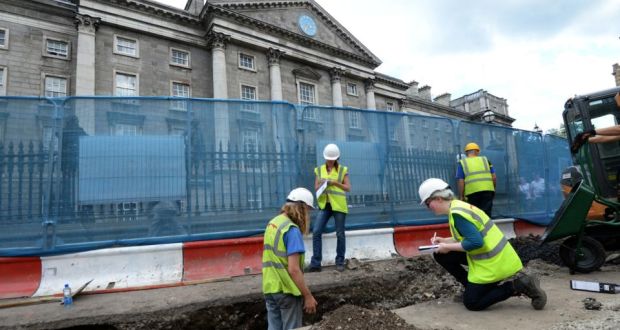The partial remains of four individuals, found in front of Trinity in July 2014 as part of the Luas Cross City project’s excavations, have been dated to between the 15th and 17th centuries.
The remains, found seven months into the construction works around Trinity and College Green, were confirmed at the time to include an adult male, while another was under the age of eighteen at the time of their death.
The age of the remains, however, has been unknown until now, with it being unclear whether they were of Viking or medieval origin without further analysis. Radiocarbon dating by Transport Infrastructure Ireland archaeologists have now ruled out any chance that the remains could have belonged to a Viking burial site.
In an email statement to The University Times , Emer Dennehy, a Transport Infrastructure Ireland archaeologist, confirmed the date of the burials, describing the remains as one of “the most significant finds from this contract.”
A team of ten archaeologists working for Rubicon Heritage Services, on behalf of the Railway Procurement Agency, found the remains while excavating a trench in front of Trinity’s Front Gate, as part of the Luas Cross City works in July 2014.
In a report seen by The University Times , which is due to be launched as a book, confirms that the bones of five individuals were found. The report also confirms that one of the individuals is an adult male, while the four others were below the age of 18 at the time of their death.
By using oxygen and strontium isotopes in the tooth enamel and dentine of the skeletons, the archaeologists hope to discover more details of the remains. The bones, according to Dennehy, are “undergoing analysis to determine their gender, age and whether they had any diseases and if their cause of death can be determined”.
As the final element of the research and post-excavation analysis, the department hope to prepare a 3D digital facial reconstruction of one skeleton, according to Dennehy.
Initially the remains were believed to be from the either the early medieval or Viking era due to their burial position, with four of the remains buried north-to-south, rather than the traditional Christian burial position of east-to-west. The grave depth of 1.5m below current ground level, and the historical records of their location, also indicated an earlier time frame.
The position of the remains, in an area with both a strong Viking and medieval heritage, meant that neither dating could be ruled out without analysis. College Green was formerly known as Hoggen Green, because of its association with two Viking burial mounds, while medieval burials have also been recorded at the Priory of All Hallows, now the site of Trinity.
The results, however, of the radiocarbon dating coincides with the final phase of the Priory and the subsequent establishment of Trinity on the site in 1592.
Other significant finds during construction for the Luas Cross City project include the foundations for an early 18th century boundary wall at Trinity, and the discovery of nearly 1,800 reinterred human remains, victims of the cholera epidemic of 1832 and reburied during railway works in 1870, near the site for the Dublin Institute of Technology (DIT) Grangegorman Luas stop.
The Luas Cross City works around College Green are due to be completed by early next year, with the overall project due to be open to the public before the end of 2017.







